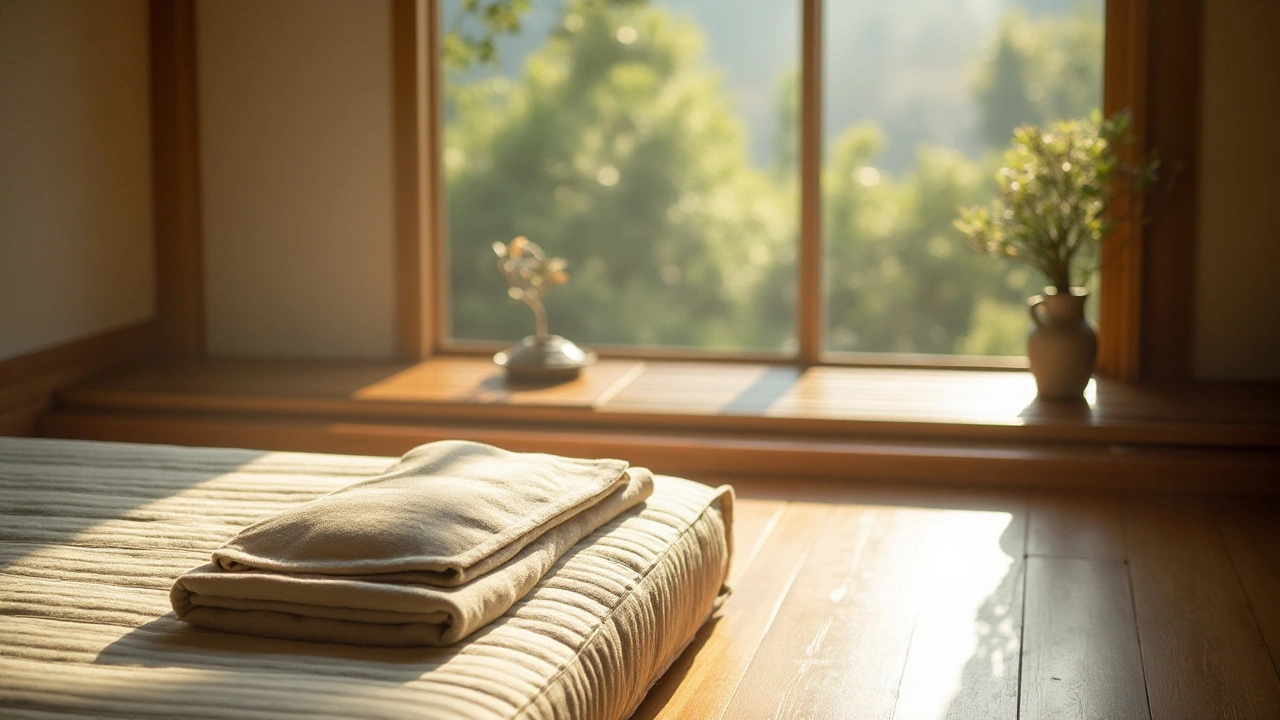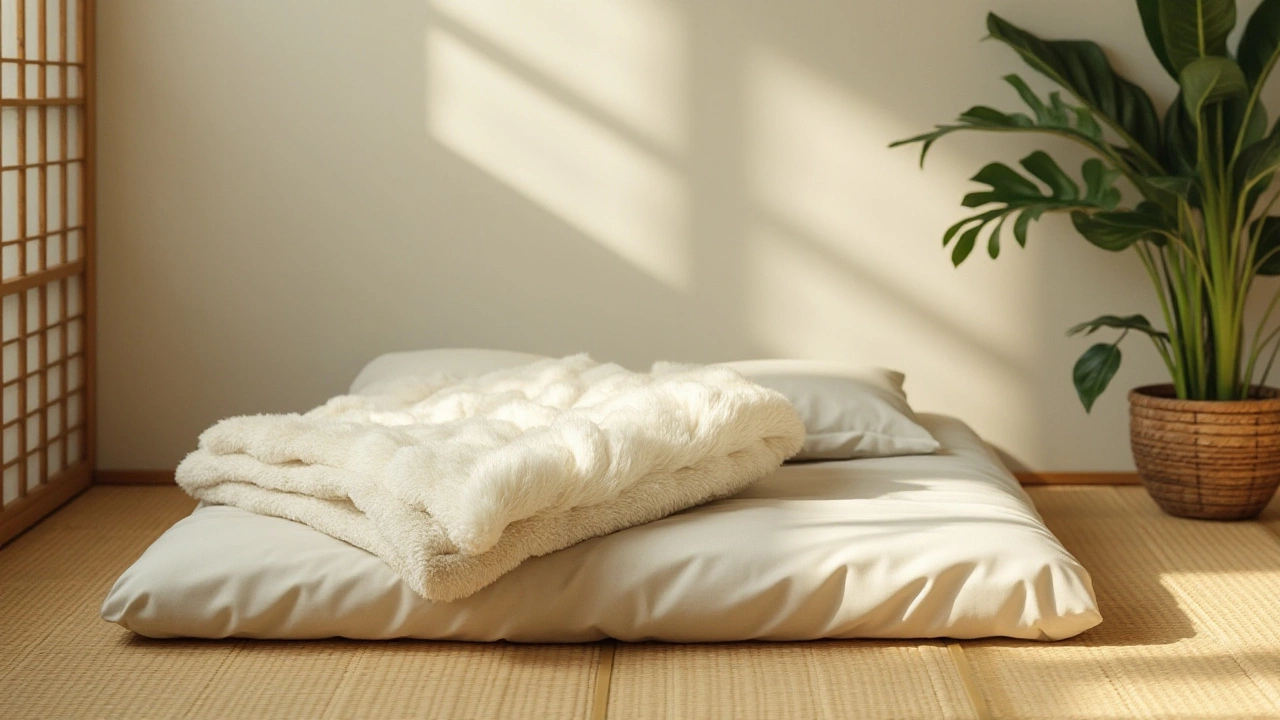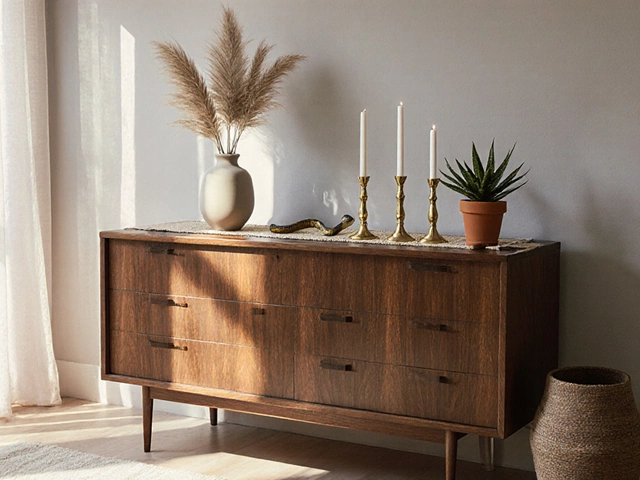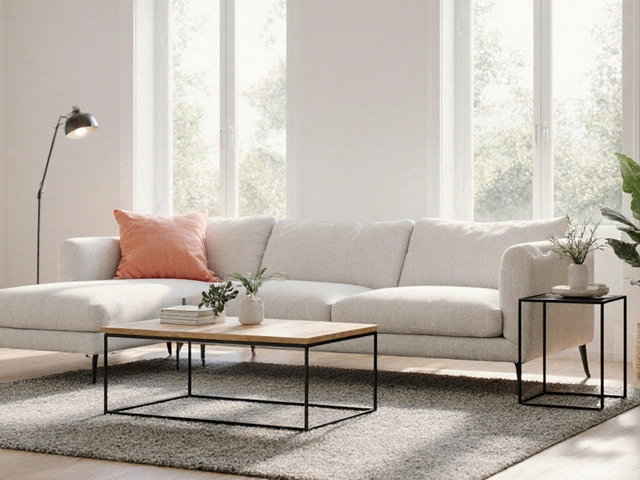Japanese culture has graced the world with many unique and intriguing practices, and their approach to bedding is no exception. Perhaps you’ve heard of Shikibuton and Kakebuton, but are you familiar with what sets them apart? While both are staple components of traditional Japanese sleep setups, each has distinct characteristics and uses.
Whether you're considering a minimalist lifestyle or just have a curious mind about different cultures, this exploration promises to enlighten and inform. From cultural insights to practical tips, this article delves into the essence of Shikibuton and Kakebuton. Discover how these traditional items can enhance your sofa bed experience.
- Defining Shikibuton and Its Purpose
- What is a Kakebuton?
- Cultural Significance in Japan
- Suitability for Sofa Beds
- Materials and Care Tips
- Choosing the Right Bedding for You
Defining Shikibuton and Its Purpose
The shikibuton is an integral part of Japanese bedding, often admired for its simplicity and functionality. Originating from Japan, this mattress is traditionally positioned directly on a Tatami mat, a type of straw flooring. Unlike Western mattresses, which typically include spring or foam cores, the shikibuton is crafted with layers of cotton batting. This difference results in a firm but comfortable surface that many find ideal for a good night's sleep. The absence of internal structures also makes the shikibuton easy to fold and store, a property that aligns with the Japanese value of maximizing space in small living areas.
Perhaps you’ve wondered about the health benefits of such a firm sleep surface. The shikibuton's structure promotes alignment of the spine, which can alleviate back pain—a common issue in the modern world. This might be why some chiropractors advocate for firmer sleep surfaces. Emphasizing its practicality, the shikibuton is easy to air out, as its design allows for ventilation with little effort. This straightforward maintenance helps prevent the build-up of humidity, a common culprit behind mold and odors.
In historical contexts, the shikibuton has long retained its role as a fundamental household item. It became widespread in Japan during the Edo period (1603–1868), where it served the samurai class and the general populace alike. The adoption of this bedding solution underscores a cultural predilection for items that embody aesthetic sleekness and pragmatic utility. The shikibuton’s minimalist form compliments Japan's architectural aesthetics, blending seamlessly with the interior settings of traditional homes.
How about the modern use of shikibuton, especially regarding its adaptability to the western concept of sofa beds? Its lightweight and foldable nature has rendered it a popular choice for multi-functional furniture. Transforming from a mattress at night to a sitting cushion during the day, the shikibuton expands what we can expect from our sleeping arrangements. It gives users the ability to optimize space without sacrificing comfort. A New York Times report on evolving urban living spaces noted, "the shikibuton represents a shift toward adaptable minimalist living," reflecting its suitability for contemporary lifestyles.
Utilizing the shikibuton can be an eye-opener for those new to Japanese bedding. Some users express initial surprise at its firmness, but often grow to appreciate its understated support and lack of bulk. As with many of Japan's venerable traditions, the practice requires a subtle adjustment but offers considerable rewards in terms of space management and sleep quality. Engaging with these traditions gives insight into different cultural values, such as simplicity, efficiency, and respect for space—concepts that are well-meaning companions in any living situation.
For individuals inclined toward sustainable living, shikibuton represents an eco-friendly choice. Cotton—being a natural material—is biodegradable and more sustainable than synthetic alternatives. This aligns with growing global consciousness towards sustainable consumer habits, resonating with environmentally aware buyers. Imagine adopting this simple yet impactful lifestyle change, knowing your choices resonate with centuries-old traditions and contribute to ecological responsibility.
"In our quest for minimalism, the shikibuton serves as a reminder that comfort and practicality can coexist in harmony," states Marie Kondo, a well-respected advisor on simplifying and organizing living spaces.
The allure of the shikibuton extends beyond mere aesthetics; it’s about reclaiming space and instilling a sense of calm and order into life's most intimate setting—the bedroom. Through understanding its historical roots and modern application, we appreciate how a seemingly simple product can make a significant impact.
What is a Kakebuton?
The Kakebuton is a vital piece of the Japanese bedding ensemble. Often hastily described as a quilt or duvet, the kakebuton embodies a unique blend of form and function that sets it apart in the world of bedding. It is traditionally used on top of the shikibuton to provide warmth and comfort during the night. Unlike the western duvets, which can often be heavy and cumbersome, the kakebuton is designed to be lightweight yet incredibly warm. This is primarily due to the use of materials like cotton or silk, which trap heat without being oppressive. Over centuries, the making of kakebuton has evolved, skillfully weaving tradition with modernity by using advanced fabrics and techniques. Thus, a typical kakebuton today offers a unique sleeping experience that cannot be replicated by conventional bedding. It resonates deeply with the minimalist lifestyle often associated with Japanese culture, offering a cozy and uncluttered solution to sleep.
Interestingly, the kakebuton is more than just a functional item; it holds cultural significance in Japan. For many Japanese families, kakebutons are part of heirlooms, passed down from one generation to the next. The idea that a simple bedding item can carry such emotional ties speaks volumes about its place in the cultural fabric. The kakebuton's utility isn't restricted to traditional homes; it has found its way into modern living spaces across the globe, including those with sofa beds. Its adaptability and functionality make it ideal for individuals seeking an easy-to-maintain, versatile bedding solution. Whether it's a chilly winter night or a mild summer evening, the kakebuton's utility remains unmatched, fulfilling diverse necessities without compromising on style or quality.
Given its unique characteristics, the kakebuton may be a worthy addition to your home. Designers around the world are paying attention to its growing popularity as a testament to how traditional pieces can blend seamlessly into contemporary settings. When picking a kakebuton, it's essential to consider the fill material, as this affects its warmth and weight. Cotton and silk are popular choices, each offering specific benefits, like breathability and luxurious feel, respectively. Another critical aspect is the cover fabric; opt for natural fibers for better skin-feel and durability. Some even argue that the choices in kakebuton materials and design can influence one’s dreams. As one celebrated designer put it,
"A kakebuton is not just bedding; it's an art piece—a synthesis of comfort and aesthetic."

Cultural Significance in Japan
In Japan, the traditions around bedding transcend mere functionality, reflecting a way of life that values simplicity and harmony. The shikibuton and kakebuton are cornerstones in this cultural tapestry, embodying more than just items for rest. These elements emphasize the Japanese principle of 'Ma,' a concept about the aesthetic of empty space, which comprises both philosophical and practical facets of daily living. Sleeping arrangements in Japanese homes have historically leaned toward minimalistic designs to maximize space and enhance functionality. This mindful approach allowed rooms to transition seamlessly between different uses throughout the day, maintaining a sense of efficiency without sacrificing comfort.
The shikibuton, serving as a foldable mattress, encapsulates a certain ingenuity that aids in this flexibility. During the Edo period, when space was often at a premium, the ability to repurpose an area transformed residential architecture and family dynamics. An interesting feature is how the shikibuton can be easily stored during the day, rolled up, or placed in a closet, revealing the room's multifunctional nature. Meanwhile, the kakebuton, which acts as a cover, often features intricate designs and embodies centuries of craftsmanship, reflecting regional differences and familial heritage. These are more than just warms blankets; they're treasures often passed between generations.
A deeper look into Japanese history reveals that before Western influences introduced raised beds, people in Japan had predominantly slept on tatami mats, paired with the shikibuton. This style not only served practical needs but also had health benefits. Sleeping close to the ground is believed to improve posture and circulation, often credited as reasons for the Japanese populace's renowned longevity and well-being. In this sense, the bedding isn't just about rest; it's an aspect of the wellness tradition deeply ingrained in Japanese culture. Today, while some modern Japanese households have adopted Western-style beds, the use of traditional futons remains widespread, a testament to their enduring appeal and versatility in contemporary settings.
"In simplicity, there is beauty." — This Japanese proverb perfectly encapsulates how the shikibuton and kakebuton reflect the elegance inherent in minimalism, crucial for fostering mental peace in an otherwise chaotic world.
Moreover, in modern Japan, the shikibuton has made a comeback as interest in sustainable living options grow globally. The futon's foldable nature reduces the need for bulky furniture, aligning with the environmental consciousness that's increasingly prevalent today. Not to mention, using a shikibuton minimizes the carbon footprint, as it is often crafted from organic materials compared to conventional mattresses that require more resources and emissions to produce. Finally, in introducing these beautiful elements of Japanese tradition into one's home, individuals are invited to experience a slice of life that emphasizes respect for both nature and personal space, a celebration of cultural originality that persists with timeless appeal.
Suitability for Sofa Beds
When it comes to outfitting a sofa bed, the search for versatile and comfortable bedding solutions can be an adventure in itself. Enter the world of Japanese bedding, specifically the shikibuton and kakebuton, each bringing unique attributes to your living space. The shikibuton, often revered for its simplicity and ease of use, can adapt beautifully to the dual functionality of a sofa bed. One of its greatest strengths lies in being a mattress that can easily be folded and stored, making it a top choice for those who need flexibility without sacrificing practicality. Positioned on a sofa bed, the shikibuton offers enough support and comfort due to its unique cotton-filled structure, which molds to the body while providing a firm surface.
The kakebuton, on the other hand, complements the shikibuton with its comforting blanket-like presence. As a layer that provides warmth, the kakebuton makes an excellent companion to a sofa bed setup, especially in colder months. Its design provides coziness without the bulkiness of traditional blankets, allowing for easy storage, which is crucial in tandem with space-saving furniture like a sofa bed. Consider the composition of a kakebuton: a soft, quilted texture filled with down or synthetic fibers, allowing for a lightweight yet warm experience.
The Minami Furniture Association notes, "Both shikibuton and kakebuton embody a harmony of form and function, ideal for modern lifestyles where space efficiency is key."
Given their adaptability, both the shikibuton and the kakebuton are not only suitable but thrive in environments where multifunctionality is essential. Their minimal footprints mean that after a restful night's sleep, you can quickly store them away, converting your sofa bed back into a cozy seat for daytime use. In the fast-paced rhythm of urban life, especially in compact living spaces, these Japanese bedding styles transcend traditional usage to become essential allies in maximizing comfort and space.
While many conventional bedding options can be cumbersome, the lightweight and foldable attributes of the shikibuton and kakebuton make them excellent choices for those looking to blend authenticity with utility. An emerging trend in urban interior design is the fusion of traditional elements with modern needs, and here, the marriage of a sofa bed with Japanese bedding fits perfectly. Should you ever venture into enhancing your own or a guest's sleeping arrangements, the inclusion of these time-tested pieces could very well enhance the experience. Such an integration not only reflects on cultural appreciation but also highlights a commitment to making the most out of limited space.

Materials and Care Tips
When it comes to the world of Japanese bedding, the **shikibuton** and **kakebuton** set the gold standard not only for comfort but also for durability. But the key to a satisfying bedding experience lies in understanding their materials and how best to care for them. Both are designed with simplicity and practicality in mind, yet their construction varies to suit their purpose. The shikibuton, recognized for its versatility as both a mattress and a support for your sofa bed, is typically made from 100% cotton or a blend of wool, which ensures breathability and comfort. Choosing a futon with a cotton construction allows for a perfect balance between firmness and softness, an ideal trait for spinal support.
Caring for your shikibuton involves regular airing and sunlight exposure. The natural materials fend off odors and bacteria when properly aired, therefore extending the lifespan of your mattress. An often-recommended practice involves taking the shikibuton outside and laying it under the sun every few weeks. This not only refreshes its fibers but also brings in a hint of nature’s freshness back into your home. An expert tip shared by
"Japanese interior designer Masako Ueno emphasizes the importance of incorporating sun drying in routine cleanliness to maintain the longevity and freshness of futons."
Kakebutons, on the other hand, act similarly to duvets or comforters and are often filled with a natural down or synthetic alternative. They are enveloped in a soft, cotton cover. The choice of down brings warmth without the weight, perfect for different seasons. When dealing with kakebutons, taking cues from traditional Japanese styles, you might consider investing in a protective cover which is not only decorative but functional, keeping the kakebuton free from dust and stains. Frequent washing of the cover is advised, while the kakebuton itself should be sent to the dry cleaners every few years unless it specifically states machine washability.
Similar to shikibutons, kakebutons also benefit from periodic airing; particularly if they are made of down, which can otherwise trap moisture and become a snug ground for mites, if neglected. By employing these care routines, you enhance the comfort and hygiene of your bedding, an important aspect when considering using these items on a **sofa bed**. Gaining insights into their materials allows you not only to find a style that reflects your personal comfort preferences but also ensures that the money spent protects your investment in quality sleep.
Choosing the Right Bedding for You
When it comes to selecting the ideal bedding for your lifestyle, it’s essential to weigh different factors that cater to your personal comfort and practical needs. Not every bedding type suits everyone and there’s a world of difference between options like a cozy kakebuton and a firm shikibuton. The essence of finding the right bedding lies in understanding your daily routine, sleep patterns, and space considerations. If you’re furnishing a compact living area or a multi-purpose space, the space-efficient nature of Japanese bedding may be highly appealing. A low-profile and easily foldable shikibuton matches well with sofa beds due to its versatility, while the plush comfort of a kakebuton enhances warmth and relaxation without cluttering your space.
Delve beyond the initial allure as you contemplate materials and practical benefits. Shikibutons boast a slim design yet ensure exceptional support for the back and spine, an ideal choice if you prioritize health and posture. Alternatively, kakebutons provide a sense of indulgence akin to enveloping oneself in clouds, perfect for chilly climates or those who sleep cold. Keep in mind that these are more than just bedding; they embody a lifestyle shift toward simplicity and efficiency. Reflect on whether you need a solution that complements urban dwelling or one that replicates the serenity found in traditional Japanese homes. Your selection likely holds sway over sleep quality, a factor often underestimated.
Considering the environmental impact of bedding materials also plays into informed decision-making. Organic cotton, wool, and other sustainably sourced materials breathe easier within a green home. Paying attention to the fill material—be it polyester or natural fibers—determines your kakebuton’s weight, warmth, and longevity. Maintenance is another pivotal part of the equation. Fostering a long-lasting relationship with your shikibuton or kakebuton involves understanding their care requirements. While shikibutons demand regular airing and sun exposure to maintain freshness, kakebutons may require professional cleaning for best upkeep. Aligning these needs with your lifestyle might tip the scales in one direction.
Your comfort should reign supreme in this endeavor, but don’t shy away from being inspired by cultural significance. The very act of adopting a shikibuton or kakebuton can be a dive into cultural appreciation and recognition of a tradition steeped in history. This intersection of person and product not only honors Japanese customs but weaves them into the fabric of modern living.
"No culture can live if it attempts to be exclusive," said Mahatma Gandhi. He alludes to the idea that embracing and integrating different cultural aspects enriches our lives beyond the familiar bounds of everyday experiences.
As you venture on this path, consider the harmonious blend of functionality, comfort, and cultural storytelling that these traditional pieces bring into your home. With the right choice, you redefine what it means to live simply yet luxuriously, fortifying your lifestyle with authenticity and heart.








